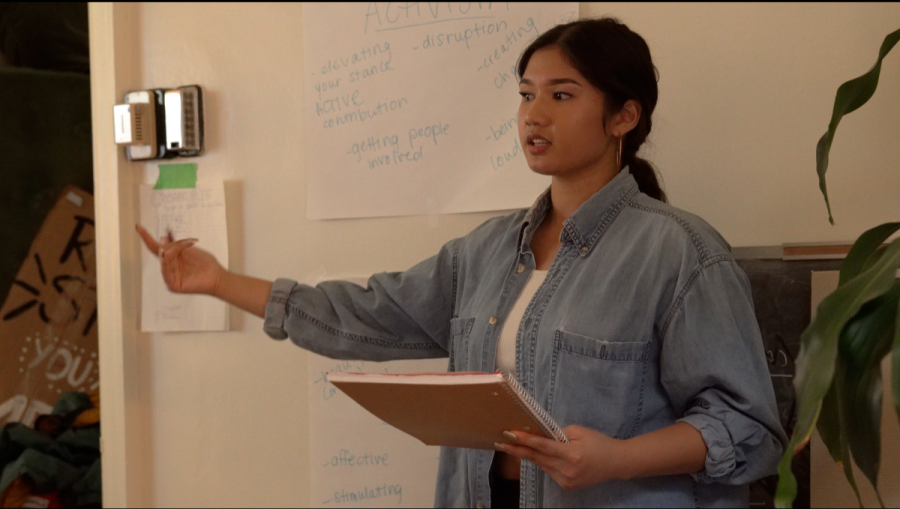My Media Creative Host First Workshop: Harnessing Art for Activism
Beatrice Dimaculangan Stresses the Power of Art in a Message
The organization My Media Creative invited community members on Oct. 10 to join them for their first workshop. It was a chance to discuss how art and activism intersect and look at how various mediums of art can drive messages of social changes.
MMC is a group of creators who develop multimedia campaigns and content for purpose-driven organizations such as non-profits, activists, and student groups, to provide them with communication and marketing services.
The workshop, Harnessing Art for Activism, took place at Building 21 in McGill University and was led by MMC community director Beatrice Dimaculangan.
While some shared their thoughts about how art can reach a broader audience, Dimaculangan pointed out that it also has the potential to reach people in a creative way.
“I think it has the potential to be a lot more engaging and a lot more emotionally impactful than a lot of traditional media,” said Dimaculangan.
Throughout her journey as an artist and activist, Dimaculangan worked with organizations such as Rap Battles for Social Justice and Anakbayan, a youth organization fighting for rights and peace in the Philippines, mostly using music and visual art to push for social change.
While an organizer and performer with Rap Battles for Social Justice, a non-profit organization based in Montreal, Dimaculangan used to hold workshops and put on concerts to raise awareness about certain issues.
With RB4SS, she did performances on issues such as representation, and sexual violence.
In the workshop, Dimaculangan presented images that were created during movements.
Black Panther Party was a political organization in the U.S. founded in 1966. Their goal was to challenge police brutality by arming citizens who would monitor officers.
The first graphic presented the image of a Black man showing the front page of a newspaper. It read, “All power to the people.”
The second one was a Black woman holding her child. A detail that no one could miss was the gun both were wearing.
Many emotions emerged from these graphics. The room could feel the anger on their faces.
For Dimaculangan, art is a tool to communicate ideas and messages. Graphic art became iconic to drive messages of social change, as it did it with the BPP.
“People were able to identify and kind of reimaging themselves in these images and these characters,” she said.
Other mediums of art have the potential to reach people in more of an emotional way, such as music.
American hip-hop group N.W.A was a part of the discussion during the workshop. The Compton group founded in 1986 was mostly known for their lyrics drawing from their experiences of racism and excessive policing.
“I think [art] has the potential to be a lot more engaging and a lot more emotionally impactful than a lot of traditional media.” Beatrice Dimaculangan
One song that comes to mind when thinking about N.W.A is “Fuck Tha Police,” which denounced police brutality and racial profiling. The lyrics and the movement behind the song had such an impact that it continues to influence today’s pop culture.
Hip-hop artists and rappers were mostly part of the discussion because they address ongoing issues such as police brutality and discrimination.
Alongside N.W.A, Childish Gambino’s song “This is America” was also mentioned as the lyrics address the wider issues of gun violence, the high rate of mass shootings, and racism in the U.S.
Let’s not forget about Kendrick Lamar, who also addresses these issues in his song “Alright.”
The message behind the song is mostly associated with the Black Lives Matter movement, which is an activist campaign against systemic racism and violence towards Black bodies.
The song was associated with the movement, with protesters singing “Alright” in unison.
“Your audience will be so much bigger, and if you do it right, and if you do it well, in a way that is creative and engaging. People are actually going to give you their attention,” said Dimaculangan.
Besides music and graphic art, MMC founder Tristan Surman has some thoughts about how huge memes can be to communicate important messages going into the twenty-first century.
“Memes find the way to kind of get at this specific emotion that everyone has had or because they are so easy to make,” said Surman. “And there is so many of them that one will resonate with you.”
For Surman, the images and videos we put on social media are the ones who have the most impact going forward.
These discussions need to happen more often according to Surman. For him, the people in his community at McGill are empowered with these art forms.
“This was just a start,” Surman said about the first MMC workshop.
For Dimaculangan, the work that MMC does is powerful.
“Now more than ever we have the power to access the tools and platforms,” said Dimaculangan. “We [youth] are the ones that have this, not only the power but in a sense of responsibility to create the future we envision for ourselves.”


_600_832_s.png)
